As a student, with oil paint on my brush
Posted: October 28, 2016 Filed under: Uncategorized 49 CommentsI’ve been wanting to learn how to paint with oils, so I few weeks ago I enrolled in a night class taught by fellow LAA member David Kelavey. I like his loose approach to landscapes and city scenes, and even though in the past I have tried to learn a bit about oils on my own, there’s nothing like watching someone paint to really understand how it’s done. Even though these are quick 7″ x 9″studies, scenes of Charlevois, each done in under an hour, I thought I’d post them and explain a bit about the process.
The way David works is to start by covering the canvas or panel with a layer of burnt sienna acrylic paint. You can see it showing through on my sketches. From there he paints the darkest areas in with a thin layer of burnt umber acrylic, and then adds in the lights with white acrylic. He calls this step a “notan”, a term I wasn’t familiar with, but it is very much like the value sketch I often create in pencil or paint before painting a watercolour. I wish I had taken a photo of that step too, but I was a little too eager to put colour down.
When the notan is dry — and acrylic dries pretty quickly — we add colour, in oil, starting with the darks. You can well imagine that as someone who has working almost exclusively in watercolour, this is a leap for me. I always know before I start out where the darks will be but I usually build up to them instead of beginning with them. From there we work the various midtones (those are the burnt sienna parts in the underpainting) and end with the lightest areas in the painting.
Last week I was quite frustrated with the process. I think I mixed too much of each colour and painted a bit like I was painting a wall, but thicker. This week I watched David a little more closely, and realized I was mixing up too much pigment with my knife. I tried to mix a little more slowly and carefully with my brush, and this week I probably went in the opposite direction. Instead of having great gobs on paint on the canvas, I used layers of paint that may be a little too thin. Eventually I hope to get it right.
There’s no need to state the obvious differences between oil and watercolour. But there is one thing that I rely on when painting in watercolour and miss when painting with oil. Watercolour surprises you. It does stuff right on the paper, stuff you can’t anticipate, as pigments combine, granulate and dry. You’re always living a little on the edge of chaos as you paint. There are no surprises with oil as you put down the paint. I guess that’s a good thing too, but what I love about watercolour is the looseness you can achieve by letting water and paint do their thing. Looseness seems harder to achieve in oil because it has to be more deliberate. It is completely dependent on how you put paint down with the brush. I will have to work on that for sure. In the meantime, I’m really enjoying learning something new. Next week: the start of a bigger painting.
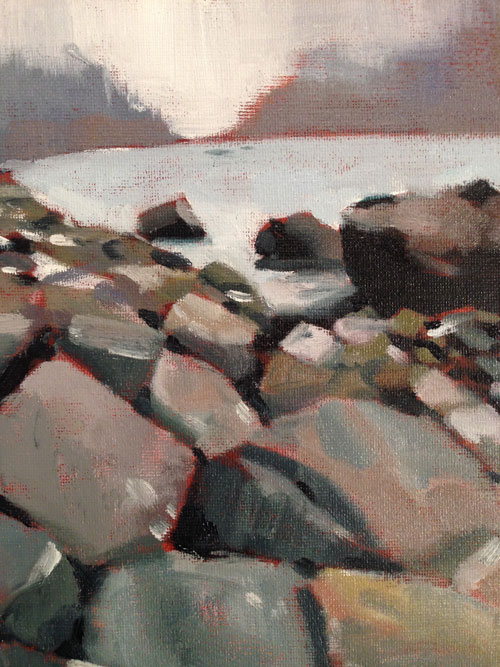

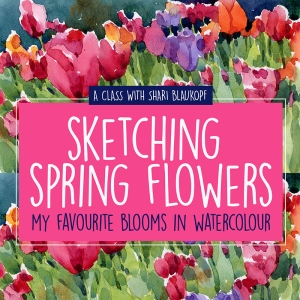

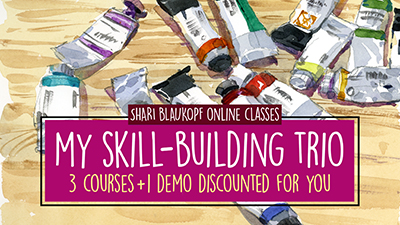
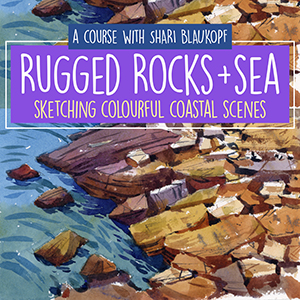


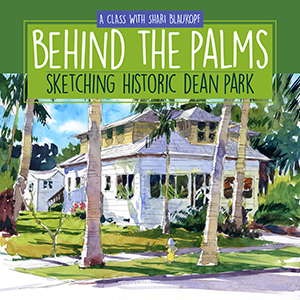

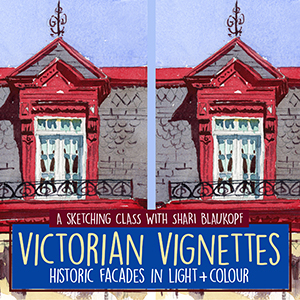
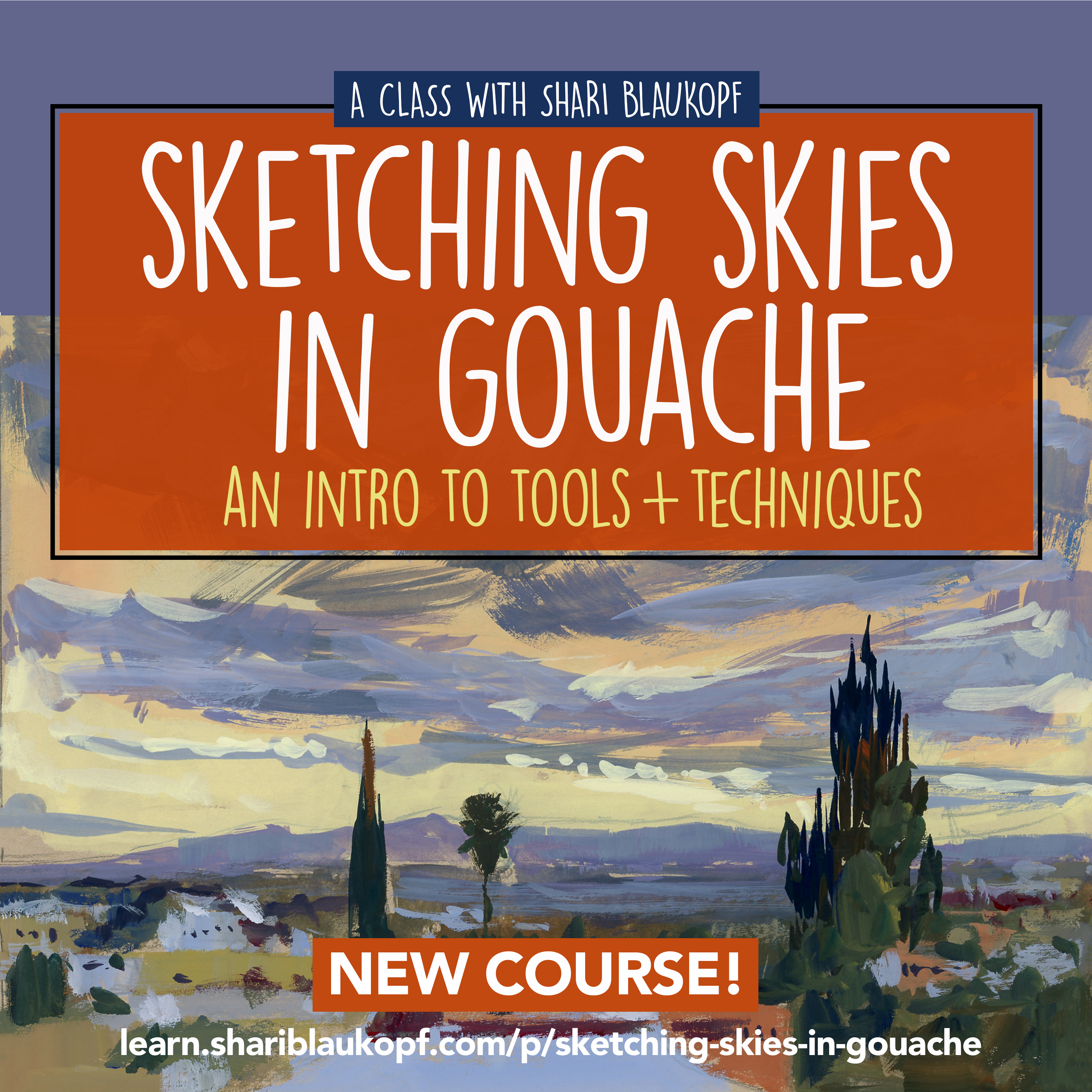
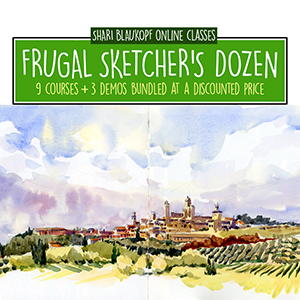

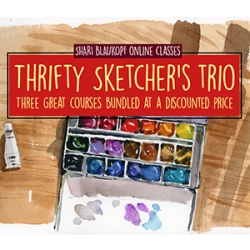
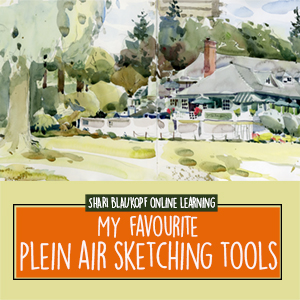
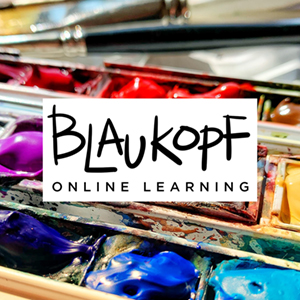
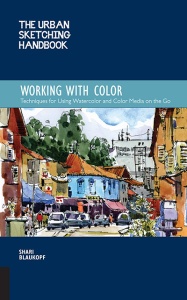
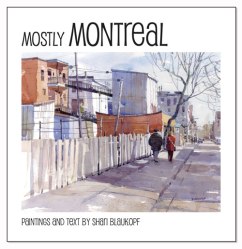


Those are great paintings! I know what you mean about the surprise in watercolor. When I first started painting in oil, I waited to see for the paints to mix on the canvas. They didn’t move. I realized that I was waiting for the paints to move and mingle as they do in watercolor. It’s something I missed for quite a while.
LikeLike
Thanks for writing Karin. It’s interesting to read all the comments for this post, often from watercolorists who have tried oil as well. When I think about the painting experience with oils, I think of something very relaxing since you can walk away from the painting and when you come back it looks exactly the same. When you walk away from a wet watercolour, you never know what you’ll find when you get back. I certainly will not give up watercolour but I am enjoying this experience.
LikeLike
Now Shari, I have an urge to get oil and follow you.. Can’t wait to see what you do with oil Fav teacher!
LikeLike
I think you may have to try this too Rooi. Not as neat at watercolour though. I always have dirty hands now and I’m finding dabs of oil paint all over the place.
LikeLike
Beautiful Shari! Two different worlds. You should sign them, because we can’t know you did them. It’s too different. They look so «soft».
LikeLike
That’s funny Marc. I don’t even have a brush that is fine enough to sign them. I only have two biggish brushes. I guess eventually they will get to look like my work…
LikeLike
These are so lovely, Shari! Your experience and deftness as a painter really show even though you’re working in a new medium. Isn’t it exciting? 🙂 I recently traveled to Japan and came home with an incurable case of Sumi-e fever. It’s still watercolor, but wow, what a difference from the traditional Western approach. I am looking forward to seeing more of your oil paintings and also to see how the two mediums influence each other in your work.
LikeLike
Hi Janine,
It’s nice to hear from you! Ah, I am jealous. I would love to go to Japan. How exciting that you learned Japanese painting techniques. It will be interesting for me too to see how this oil thing changes my watercolours. I already work with watercolour paint that is sometimes quite thick which is why I wanted to try oils. We’ll see where this goes.
Thanks for writing!
LikeLike
I am constantly impressed and inspired by you. As a skilled water colorist you decided to take an Oil painting class! How wonderful to expand your skills and acknowledge, your weakness in areas where you have had less time, less interest less success initially…until now. You are humble and show us, who are far less skilled, how to take chances with what is unfamiliar. Thank you for your commitment to teach us how to find a way, to always do your best. Your father would be so proud of you! Thank you, for you. Bernadette
Sent from my iPad
>
LikeLike
Bernadette, you are very sweet to think of my father. I think of him every time I post because he loved to read the blog and especially the comments. And I think he would have loved to see what I am learning in oil painting.
I’m really enjoying being a student, and happy to share what I learn. Thanks for reading!
LikeLike
Well, all your drawing skills certainly shine through. Great rock volume.
LikeLike
Thanks Alison. I have to admit I didn’t pick anything really difficult to draw in either of these, but of course I chose rocks because I love painting them, even in oil.
LikeLike
Congrats on trying oils! I see your wonderful style shine through on these.
LikeLike
Thanks Linda! Have you ever tried oils?
LikeLike
I have not painted in oils since college days….a loooonnng time ago!
I’m tempted frequently except I lack a proper space for a somewhat messier and smellier media!
LikeLike
Hi Shari, I found this book about Notan very helpful:
Notan: The Dark-Light Principle of Design
By Dorr Bothwell, Marlys Mayfield
80 pages
Published: September 19, 1991
ISBN13: 9780486268569
The information above here is from Goodreads.Com. It’s a small, inexpensive, but quite technical discussion with many very challenging exercises on how to design using Notan.
Hope you enjoy it as much as i did. I think I got it from Dover Books.
Best
Jess
LikeLike
Hi Jess,
Thanks so much for the book recommendation. This has been such an interesting post for me because of the responses. I now have books to look up, painters to research and new techniques to try. I love it!
I’ll check out the book, maybe even in my library.
Shari
LikeLike
They look NOTHING like Shari Blaukopf watercolors, but I would know your “eye” in a heartbeat! They look like Shari Blaukopf OILS! OH MY! I’m not sure I’ll ever migrate over with you, but it’s interesting to see how you deal with this very different medium. I say BRAVO!
LikeLike
That’s funny! You’re right, these look nothing like my usual watercolours but I’m glad to hear that at least they look like they were done by me. We’ll see where this goes for me too. I may never go back to oils after the class, but we’ll see. I do find painting with oils very relaxing.
LikeLike
How funny…kindred spirits…I too am experimenting with oils (the watermixable kind) and trying my hand at the figure…haven’t ventured out yet to attempt the landscape…but it is immensely satisfying and such a fun change of pace from sloshing the watercolors around…not that I’ll abandon those…ever. But a nice way to stretch the artistic muscles and keep forging ahead in new directions! Hope you are well!
LikeLike
Hi Annelein. It’s great to hear from you! I really was hoping to make it back to Vermont this fall to paint the quarry but my father was ill and sadly, he passed away in September. I hope we get to paint together soon though, maybe in the spring. I would love to see what you do with oils. It’s so funny to read that you are trying this too. As someone who used to be an art supply retailer, I’m surprised you’ve never tried these. But I know that whatever you do will be amazing. Hope all is well with you.
Shari
LikeLike
So sorry about your father’s passing. Be well and any time you venture south of the border into my neighborhood I would love to get together and paint in whichever medium!
LikeLike
Port au Persil is a beautifull place in Chelevoix. That scene as been painted many times by lots of artists including me.
You did good. With you experience in sketching you will get better in oil. Can’t wait to see your next one.
good luck.
LikeLike
Thanks Andre. Of course you would recognize these scenes. The other one is from Baie des Rochers. Not sure if you have been there.
LikeLike
Hi Shari. Great beginnings in oil. Really nice. Surprised that you’ve never heard the term “notan” before (Japanese for dark/light). BTW, you can make oils behave just like watercolor if you want to. Since the binding agent is linseed oil, just add enough to make the paint super fluid. Don’t stand the canvas up vertically of course, but a nice 45 degree slant will get soupy oils running nicely. Its the same pigment as watercolor, just with a different binder (rather than gum arabic for watercolor). Why most oils painters don’t liquefy the paint is that the layers take too long to dry (much longer dry time than WC), due to the linseed oil base. There is a counter to that issue, which leads to other materials, but it can be done.
You should also check out the work of Mike Svob sometime. http://www.whiterockgallery.com/Mike_Svob.htm
He’s out of White Rock, BC.
LikeLike
Hi Russell,
Thanks for the great tip about linseed oil. I’d love to try oils when they are thinned. As you can imagine, I have a lot of experimentation to do. Have you ever painted with oils?
I just checked out Mike Svob. Really nice work, and lots to study in there. Thanks for sharing that!
Shari
LikeLike
I worked in oils years ago, but developed allergies to the various thinners and solvents (I grew up in a machine shop with even worse stuff which is why that happened). I tried water soluble oils, but didn’t like the “feel” of them for some reason (water and oils just doesn’t seem right somehow). I finally switched to painting just with the knife. I haven’t done an oil in years now. With respect to watercolor, oils are like painting in goo and mud. They just sit there.
Mike Svob wrote a book years ago (Paint Red Hot Landscapes that Sell – 2002), and he describes the basic process that you appear to be using (i.e. 3 value pattern in acrylics, then oils on top), which is more or less a standard approach these days. That method is an offshoot of the older method using a toned under painting. Of course, you can also use a colored block in for various reasons (see Paul Bailey’s work on Flickr).
The advantage to oils is time (time to work while the medium is “wet”). The disadvantage to oils is time (they stay wet long after you’re done). Oils take more care than a watercolor as you should varnish them six months after painting, and then you have to re-varnish them by decades. Oil paint doesn’t bond with the ground which is why the paint cracks over the long run (watercolors actually bond to the paper making them permanent).
On the plus side, galleries don’t have to alter their lighting to hang them vs. watercolors (under glass). Unfortunately, this sigma is why watercolors don’t get the respect they deserve.
Then there is that “fun” factor. Watercolor does kooky things when left alone to work on its own. Oils just sit there, and sit there, and sit there. Hey, what do you expect from a mud pile?
I think you’ll enjoy the experience, and your watercolors will get better for it.
LikeLike
These are lovely- such an inspiration when someone so experienced tries something new!
Your drawing and compositional skills shine through – I’d know your work anywhere 🙂
LikeLike
Thanks so much for the nice comments Elena.
LikeLike
I WOULD CALL YOU A FAST LEARNER..MOVE TO THE FRONT OF THE CLASS PLEASE:)
Sorry for the screaming:)
LikeLike
I think learning about the tools in new for me, but I guess I have some experience in colour and composition already so that might make it a little easier for me.
LikeLike
These are so different from your watercolors. Enjoy the class!
LikeLike
I am enjoying it. Thanks Joan.
LikeLike
Peter Huntoon is a water colorist who took up painting with oil. He always starts with what he calls “the chaos” and then carves it into order. I am mentioning this because there are many approaches to oil. He thins his first layer with solvent and drips, splashes, and uses huge brushes to create the foundation very abstractly then pulls it together. He is worth checking out and he has some demo videos you can watch (look at ‘quick links’ on he upper left where videos are listed). I think you might like this approach. peterhuntoon.com
LikeLike
thanks for the link Christine. I did check him out. Very nice work and quite a beautiful setup that he has in his studio. I am jealous! And a good businessman too with the weekly auctions. Still have to watch the video clips which will be the best part for sure. Many thank for sharing this.
LikeLike
Well done!
LikeLike
Thanks Andrea!
LikeLiked by 1 person
beautiful first attempts! For my favorite artist that uses this technique please look at….http://www.justlittleart.com/blog/ I’m absolutely in love with her art…
LikeLike
Thanks so much for sharing Justina’s work. Really nice and fresh. And worth another look for sure.
LikeLike
Your beginnings look good and I wish this teacher had a place where we could see his instruction in action. Many of us are far removed from cities where art courses such as his are taught in the evening. Thanks for sharing Shari
LikeLike
Thanks Lee. I don’t think David has any online videos but you are right in the middle of Florida. Aren’t there any good teachers around? I would think you are in a very populated area but I guess I am wrong. Come to Montreal for a visit again!!
LikeLike
Check out Stapleton Kearns: blog http://stapletonkearns.blogspot.com/ for a great deal of information about oil painting embedded in lots of other stuff. He’s a good writer and makes his living selling landscapes. For example, he uses an underpainting in acrylic he calls “pornstar pink” and has to bottle it for friends! You might want to find on the internet about Sargent’s oil technique. Some students of his wrote about it. He started with the mid tones and then went light and dark. Then there’s Frank Reilly who recommended laying out “strings” of various hues varying from dark value to light on the palette.
LikeLike
Hi Richard. I actually met Stapleton Kearns this past summer. We were both painting at the same plein air event. He is a very talented painter. And thanks so much for the link to his blog. What an amazing archive of knowledge. Tremendous. I just real about the pink paint on one of his posts. It will take me weeks to read them all but I really appreciate your comment.
LikeLike
I really like your use of red in the shadows, your delicate use of greys, and the perfectly structured composition. Did you make thumbnails for these too?
LikeLike
Hi Delphine. It’s so nice to hear from you. I didn’t make thumbnails of these. I just drew with burnt umber on the paintbrush. Have you ever tried oils?
LikeLike
Hi, Shari – I just found you blog after looking at Lines and Colors although I have admired your Urban Sketcher work for years. You are such a skilled artist and will do well in whatever medium you try. I work in watercolor, soft pastel and oil. I also like to play with inks. I think I would get bored with just one medium but there is the problem of being a master of none, too. Still I think working in at least 2 mediums is always a good idea. And things you learn in one do inform the other in ways you sometimes don’t expect. Thanks for this post and explaining how your teacher starts his paintings. Also it is great that you mixed too much paint! Most people don’t mix enough, myself included. I use Gamsol mediums and they also make a solvent free gel that friends of mine with sensitivities like very much. Have fun and hope you will let us know how it’s going in the class.
LikeLike
Thanks so much for writing Patricia. I agree with you — I think that what I am doing in oil will certainly help me in watercolours. I am happy to hear that you like trying different things too. I sometimes get the feeling that people think that if you work in one medium, then that is all you should do. I love to learn about everything and some day I would love to try pastel as well. So keep watching and you will find out where there journey with oils takes me.
LikeLike
Just read through all the comments. Since your post have been thinking a lot about your trying oils .Ironically, it has been the reverse for me. I relate to Russell as I had a similar experience. I started in oils . The art school I went to in Philadelphia was very ” classical” and all oils. Didn’t take long before I could not tolerate the smell or the feel of the oil. I was one of the first who switched to acrylic and then watercolor which was frowned on.
And now, years later, I have really begun to enjoy watercolors thanks to your Craftsy course. All these years I have used colored pencils, gauche and acrylics and even egg tempera. I am now happier than ever with my art. And–voila, you are now into oils. You are an accomplished artist and your work shows you can work well in other media. But I feel there is nothing as lovely as the paper glowing thru the watercolors. They are fresher to me. Cleaner. More portable as well. Again I thank you for getting me into the media I always wanted to use.
LikeLike
Hi Judy,
Thanks so much for taking the time to tell me a little bit about your history with oils. It is fascinating to me to hear how people arrive at sketching — sometimes it is their first foray into art and with other people, like you, it is because they are happy to find something that is less time consuming and more portable than oils or acrylics.
I think I will always love to paint in watercolour, for exactly the reasons you list — the transparency, the freshness of the white paper, the glow of the paint. But I love to learn, and it is a pleasure for me to learn about oil. Not sure where this will take me but I am just enjoying the experience of learning. And so glad to hear that the Craftsy classes have made such a difference for you. That makes me really happy.
Shari
LikeLike